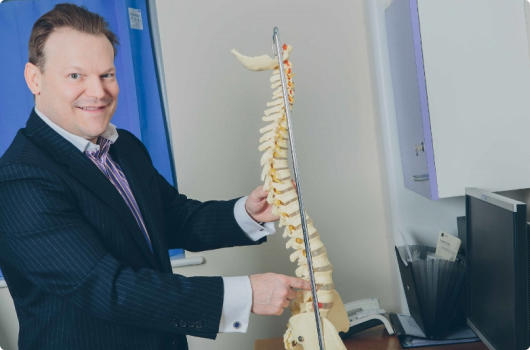Spinal Stenosis Treatment
At Spine Art, we recognise the debilitating effects of spinal stenosis, whether it manifests in the lumbar or cervical regions. Our team of skilled spinal surgeons specialises in the diagnosis and treatment of this condition, offering personalised care tailored to each patient’s unique needs. From advanced diagnostic techniques to cutting-edge surgical interventions, we are committed to providing comprehensive solutions to alleviate your discomfort and improve your quality of life. Don’t let spinal stenosis hold you back any longer. Take the first step towards relief by scheduling a consultation with our expert team.
If you have any questions or want to find out more please call our secretary, Bev on 07539 330360 or email at secretary@spineart.org.
Book a consultation
What Is Spinal Stenosis?
Spinal stenosis is a medical condition characterised by the narrowing of the spaces within the spine, which can put pressure on the nerves travelling through the spinal canal. This compression of the nerves can lead to pain, tingling, numbness, or weakness in the arms, legs, or back. Spinal stenosis can develop gradually over time, often due to age-related changes such as the thickening of ligaments or the formation of bone spurs, and it commonly affects older adults. Treatment options for spinal stenosis may include medication, physical therapy, corticosteroid injections, or, in severe cases, surgery to relieve pressure on the nerves and alleviate symptoms.
Types of Spinal Stenosis
The two primary types of spinal stenosis are:
- Lumbar Stenosis: Lumbar Stenosis affecting the lower back, and cervical stenosis, impacting the neck. Lumbar stenosis can cause lower back pain, leg pain, leg weakness, numbness, or tingling when walking, with diagnosis typically involving physical examination and imaging studies like X-rays or MRI scans. Physical examination may yield little in the way of physical signs in lumbar stenosis – this is very typical of this condition. Treatment may include medication, physical therapy, foraminal epidural injections or surgery.
- Cervical Stenosis: Cervical Stenosis can lead to neck pain, arm weakness, numbness, or coordination issues, with similar diagnostic methods as lumbar stenosis. Cervical stenosis commonly affects important reflexes in the hands and legs as a result of spinal cord compression or myelopathy. This is often found on examination by the surgeon. Treatment options for cervical stenosis may also involve medication, physical therapy, or surgical intervention tailored to individual needs and severity of symptoms.
What are the Causes & Risk Factors of Spinal Stenosis?
Spinal stenosis can arise from a multitude of causes and risk factors, significantly impacting individuals as they age. Advancing age, genetic predisposition to multiple level spinal degeneration, scoliosis, certain sports and previous spinal surgery are risk factors for the development of spinal stenosis. Understanding these causes and risk factors is essential for effectively managing spinal stenosis. Additional contributing factors include:
- Age-Related Degeneration – Over time, wear and tear on the spine can lead to degenerative changes, such as thickening of ligaments or the formation of bone spurs, narrowing the spinal canal.
- Herniated Discs – When the soft inner material of a spinal disc protrudes through its tough outer shell, it can encroach on the spinal canal, contributing to stenosis.
- Spinal Arthritis – Degenerative changes in the joints of the spine, commonly associated with conditions like osteoarthritis, can lead to inflammation and narrowing of the spinal canal.
- Spinal Injuries – Traumatic events, such as fractures or dislocations, can cause structural damage to the spine, resulting in spinal stenosis.
What are the Symptoms of Spinal Stenosis?
Recognising the symptoms of spinal stenosis is crucial for early diagnosis and effective management of the condition. According to our expert team, these symptoms may include:
- Back Pain – Often localised to the affected area of the spine, back pain may be persistent or intermittent. This relates to the underlying degeneration or problem giving rise to the stenosis.
- Leg Pain – Characterised by a dull or aching sensation, leg pain can radiate from the lower back into the buttocks, thighs, or calves when standing or walking. It can affect one or both legs and stop people after a few hundred yards. Leaning forward often relieves the pain.
- Numbness – A loss of sensation or tingling sensation in the legs, feet, or buttocks, often accompanied by weakness. It is sometimes heard that this “feels like walking on cotton wool”.
- Tingling – Sensations of pins and needles or “electric” tingling, typically experienced in the legs or feet.
- Weakness – Reduced strength or difficulty lifting or moving the legs, especially when walking or standing. A sensation that the legs don’t quite belong to the patient or aren’t responding to commands is not uncommon.
- Difficulty Walking – Impaired mobility, including a feeling of heaviness or instability in the legs, particularly during prolonged activity. Walking distance often deteriorates slowly over time – this is a clue to seek help.
How is Spinal Stenosis diagnosed?
The diagnostic process for evaluating spinal stenosis typically begins with a thorough medical history assessment, where our surgeon gathers information about the onset, duration, and characteristics of symptoms and any relevant medical history or previous spine-related issues. Following this, a physical examination is conducted to assess range of motion, muscle strength, reflexes and sensation in the affected area. Imaging studies such as X-rays, MRI (Magnetic Resonance Imaging), or CT scans are often ordered to visualise the spine and surrounding structures in detail, aiding in identifying potential causes of spinal stenosis such as herniated discs, spinal arthritis, or scoliosis and other structural abnormalities.
In some cases, diagnostic injections, such as guided foraminal epidural steroid injections or nerve blocks, may be used to confirm the source of pain by temporarily numbing specific nerves or joints. By combining information gathered from medical history, physical examination, and diagnostic tests, healthcare providers can accurately diagnose spinal stenosis and develop an appropriate treatment plan tailored to the individual needs of the patient.

What are the Treatment Options for Spinal Stenosis?
Treatment options for spinal stenosis encompass a range of conservative and advanced modalities aimed at alleviating symptoms and improving overall function. Conservative approaches may include rest, physical therapy, chiropractic care, and medications such as NSAIDs or neural modulators to manage pain, neural symptoms and inflammation. Additionally, therapeutic exercises tailored to strengthen back muscles and improve flexibility can aid symptom management. In more severe or refractory cases, advanced treatment options such as foraminal epidural steroid injections, minimally invasive procedures such as percutaneous disc decompression or open surgical decompression surgery (interlaminar decompression) may be considered to relieve pressure on the lumbar nerve roots and alleviate symptoms.
Cervical spinal stenosis surgery usually consists of anterior cervical decompression or ACDF for short.
Contact Spine Art to Learn More About Spinal Stenosis
Experience the difference our specialised spinal stenosis treatment services can make in your life at Spine Art. Our dedicated team of spinal surgeons is committed to providing you with personalised care aimed at alleviating your symptoms and restoring your mobility. Don’t let spinal stenosis limit your activities or diminish your quality of life any longer. Take control of your health today by scheduling a consultation with us. Together, we’ll work towards a future free from the constraints of spinal stenosis.
What is the cost of the procedure?
SpineArt fees due at the point of booking
Lumbar Decompression Surgery
Open decompression uses surgery to remove part of the damaged disc and bony spurs making the spinal canal bigger and thus relieve the pressure on the nerves and alleviate the pain.
View full price list£5,650*
*Prices correct as of July 2022. Please note these are fees due to SpineArt Ltd directly, hospital fees will be charged separately.
Want to talk to someone or book an appointment?
If your still unsure and have any questions, contact our receptionist Bev on 07539 330360 to arrange a consultation with Dan Fagan or email us at secretary@spineart.org.
Get in touch Book a consultation







